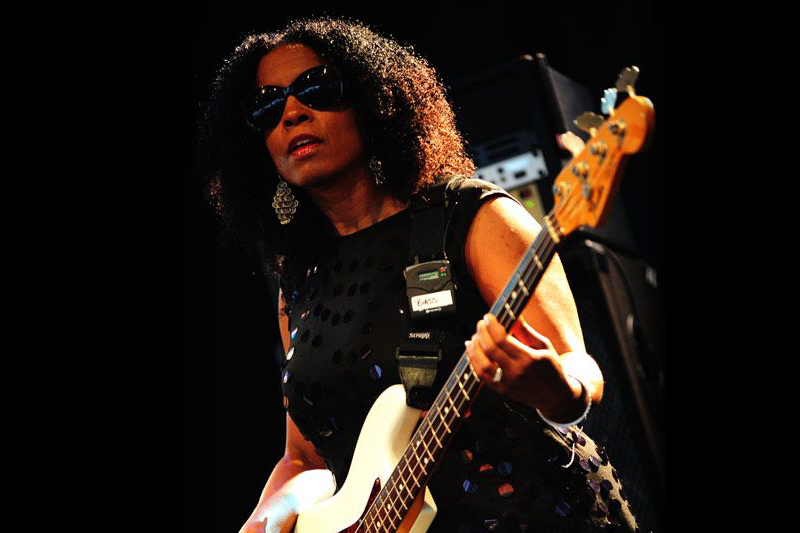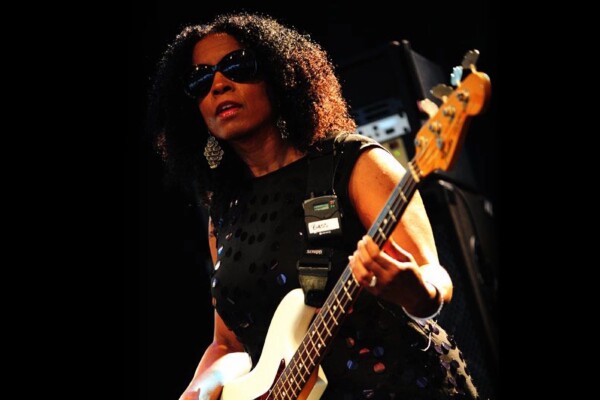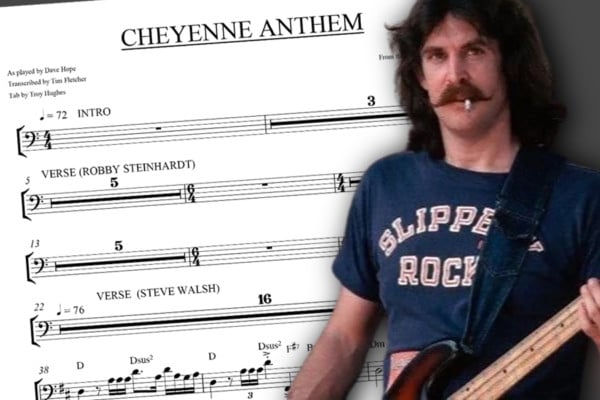Bass Transcription: Tracy Wormworth’s Bass Line on “Christmas Wrapping” by The Waitresses

This song is one that seems to be played everywhere you go during the holiday season, although it wasn’t a big hit when it was first released in 1981. However, in recent times it has become a radio staple over the festive period and has appeared on many Christmas compilation albums.
Tracy Wormworth was born in New York on December 15th, 1958, into a musical family; her father Jimmy was a jazz drummer, and her brother and sister both became able musicians. In the Wormworth family, the children were expected to learn the piano, but she also played the clarinet, while her brother learned the trumpet and her sister the violin. Her parents exposed the children to works by classical composers, and her father also encouraged them to listen to his jazz records by musicians such as Miles Davis, Dizzy Gillespie, and Charlie Parker. In addition to her parents’ music choices, the radio and TV allowed Wormworth to hear the great R & B artists of the era, including James Brown, Sly Stone, and the songs coming out of the Motown Hit Factory.
When Tracy was five years old, she began to attend dance classes and quickly became enthralled by the world of ballet. Becoming a ballerina soon became her main ambition, and she worked towards this through her teens and into her freshman year at university. When she discovered that she could attend ballet classes closer to home, she took a year out from her studies. Living back at home also enabled her to go to jazz gigs in Greenwich Village with her father, and this put her in contact with local jazz musicians. At one club, she met a bass player who became her boyfriend, bought Tracy her first bass, and encouraged her to play. This relationship brought Tracy into contact with a wider range of younger musicians, including Kenny Kirkland, and Branford and Wynton Marsalis.
The relationship with the bass player – who may have been Marcus Miller, but this remains unconfirmed – didn’t last, but the one she had with the bass continued for the rest of her life. The bass quickly became an obsession – as Tracy recalls: “I started playing it all the time. I slept with it, and when I woke up with it in my arms, I played it. I got kinda crazy with it”. She began to play gigs with her brother, now working in New York as a drummer, and her sister, who had been studying at Berklee as a singer.
Soon, Tracy was playing in jazz and fusion bands around New York, and she also started to audition for better paying gigs with more established artists. Until this happened, she held down a day job as an office worker to pay the rent and bills and took her bass into the office to practice in breaks. One day, she was carrying her bass into work, and a stranger stopped her in the street and said that his friend’s band was looking for a bass player. This contact led to an audition for The Waitresses, a band formed by guitarist and songwriter Chris Butler. Butler had previously signed a record deal with Ze Records on the strength of one song – “I Know What Boys Like” – and formed a band to record and promote the single. This had initially only been an underground hit but managed to chart in the UK, Australia, and the US on its re-release. This led to the recording of the band’s debut album Wasn’t Tomorrow Wonderful? (1982), but their bass player Dave Hofstra left after their first album, and they needed a replacement for an upcoming tour. Tracy’s audition was successful, and she joined the band.
Soon after she joined The Waitresses, their record label asked the band to contribute to the album A Christmas Record (1981) featuring the label’s artists. Chris Butler – who actually hated Christmas – wrote “Christmas Wrapping” using some riffs that he had discarded, and a lyric he had completed in the taxi on the way to the recording session. The song was recorded in August 1981 at Electric Ladyland studios in Greenwich Village. After the recording, the band went back on the road and were very surprised that the song had become a hit single that Christmas. It was also a hit in the UK the following year and has since been covered many times, including versions by The Spice Girls, Kylie Minogue and Electric Six, and it was featured in an episode of Glee in 2011.
The Waitresses were asked to record the theme tune for the 1982 Sarah Jessica Parker sitcom “Square Pegs” and also appeared in the pilot episode. The “Square Pegs Theme” and “Christmas Wrapping” appeared on their 1982 EP I Could Rule the World If I Could Only Get the Parts. The band recorded another album, Bruiseology, in 1983, and an EP called Make the Weather in 1984. Sadly, this would be their final recording, as, after a brief line-up change, the band broke up later that year.
After this, Tracy became part of vocalist Phyllis Hyman’s band and worked with her for three years. Her connection with Kenny Kirkland then provided the next step in Tracy’s career: Kirkland was now working with Sting, who had recently become a solo artist, and Kirkland recommended her to become Sting’s touring bass player (as he had opted to play guitar). Tracy worked with Sting for fourteen months, between late 1987 and the start of 1989.
After Tracy left Sting’s band, she almost became the bass player for The Rolling Stones – having auditioned for the role after Bill Wyman left the band – but the position was eventually given to Darryl Jones. In 1990, she started working with the B-52s, joining them for their “Cosmic” tour. She also played on tracks on 1992’s Good Stuff and 2008’s Funplex, as well as their live album With the Wild Crowd! Live in Athens, GA (2011) and the soundtrack album for the movie “The Flintstones.” Wormworth is still a member of the B-52s touring band.
Wormworth has also toured with Wayne Shorter, Cyndi Lauper, and Joan Osbourne, and played in the house band for the Rosie O’Donnell show for six years, where she played with many guest artists including Liza Minelli and Little Richard. Although the role required her to play double bass, she wasn’t really confident playing one. She commented later that “they wanted a bassist who could do upright bass as well as electric, and I told them I’d do it even though I didn’t play upright. Haha! I borrowed an upright, went to the audition and luckily they just wanted me to groove on an electric. And that’s how I got the gig! And I did have to play upright once, but fortunately, the song was in A, so it was basically all open strings.”
Away from the stage, Tracy has recorded with Lena Horne, Des’ree, Regina Carter, David Lee Roth and Paula Abdul. Tracy has stated that her influences included Jaco Pastorius, Anthony Jackson, Marcus Miller, Bobby Valentin, Bobby Rodriguez, Israel ‘Cachao’ Lopez and Bernard Edwards.
Wormworth favors Fender, Sadowski, Atelier and PRS basses, and uses Aguilar and Eden amplification.
Christmas Wrapping
Wormworth has said that her bass line on this track was heavily influenced by the playing of Bernard Edwards; “Chic was really popular with “Good Times,” and that’s where the inspiration for that bassline came from. I was so inspired by what Bernard Edwards played”.
The song starts with some traditional sleigh bells and then a tinkly piano, but the Christmassy sounds are soon disrupted by an overdriven electric guitar melody and then a tasteful bass figure which ends in a very pleasing tenth interval that sustains over the next few bars. This is followed by some aggressive-sounding bass slides that lead into a 3/4 unison riff (bar 11). This unison figure appears in a few places later in the song. This is followed by four bars of A root-notes – initially in crotchets, then in quavers an octave higher.
The main bass riff starts at bar 16 and this relies on some rather nimble syncopation and hammer-ons and pull-offs. The riff is four bars long and is played twice in this section with a few small variations of rhythm and pitch. It is repeated four times for the verse which starts at bar 24, although the final bar of the fourth repeat is replaced with the 3/4 unison riff.
This leads into the first four-bar horn riff section, supported mostly by crotchet A notes in the bass, which is followed by a verse, and the initial horn riff section, as before. This time it is followed by new material: a key-change brings in a new horn riff based on D and G chords. The bass line here is perhaps less funky than the verses, having perhaps a more R & B vibe, but still has movement and it adds some interest to a simple chord sequence. The riff is repeated three and a half times, replacing the final bar with a bar of 2/4, leading into a two-bar descending line that introduces the first full chorus, which is again built around a pedal A crotchet idea.
The remainder of the song is constructed from the same verse, horn riffs, and chorus sections.
Download the transcription and follow along with the video:
It’s been great fun curating this series, and I’d like to thank those who made suggestions for bass players to cover. Thanks for all your interest and support this year, and a special thanks to Corey Brown and Kevin Johnson for letting me contribute my scribble to No Treble. I’m going to take a break from the “unsung bassists” idea for a while, but I may be back with another series in the future – it would have to be something like ‘the rest of the world’, which sounds scary!
Anyway, have a great holiday season, and a happy New Year.



That bass line is not only funky, but it is now iconic.
Thanks for the transcription — the bass part is fantastic!
Thanks Jim. It’s more complex than it sounds – Tracey did a great job on this.